Criminal Law and Law Enforcement: Trends, Budget, and Management
VerifiedAdded on 2023/04/23
|10
|2389
|136
Report
AI Summary
This report provides an in-depth analysis of law enforcement trends in the United States, examining historical context, present practices, and future projections. It begins by outlining the past trends, including the Political Era and the Professional Model Era, highlighting the evolution of technology and policing strategies. The report then discusses current trends such as community-oriented policing, the use of advanced technology like body cameras and social media, and the increasing emphasis on gender equality within law enforcement. Looking ahead, the report identifies future trends such as the impact of an aging population, immigration, and domestic terrorism, as well as the continued integration of technology. It also explores the budgetary and managerial implications of these trends on law enforcement, courts, and correctional facilities, emphasizing the need for increased financial capacities to support future developments. This document is available on Desklib, a platform offering a wide range of study resources for students.

Running Head: CRIMINAL LAW
Law Enforcement
Name
Affiliation
Instructor
Date
Law Enforcement
Name
Affiliation
Instructor
Date
Paraphrase This Document
Need a fresh take? Get an instant paraphrase of this document with our AI Paraphraser
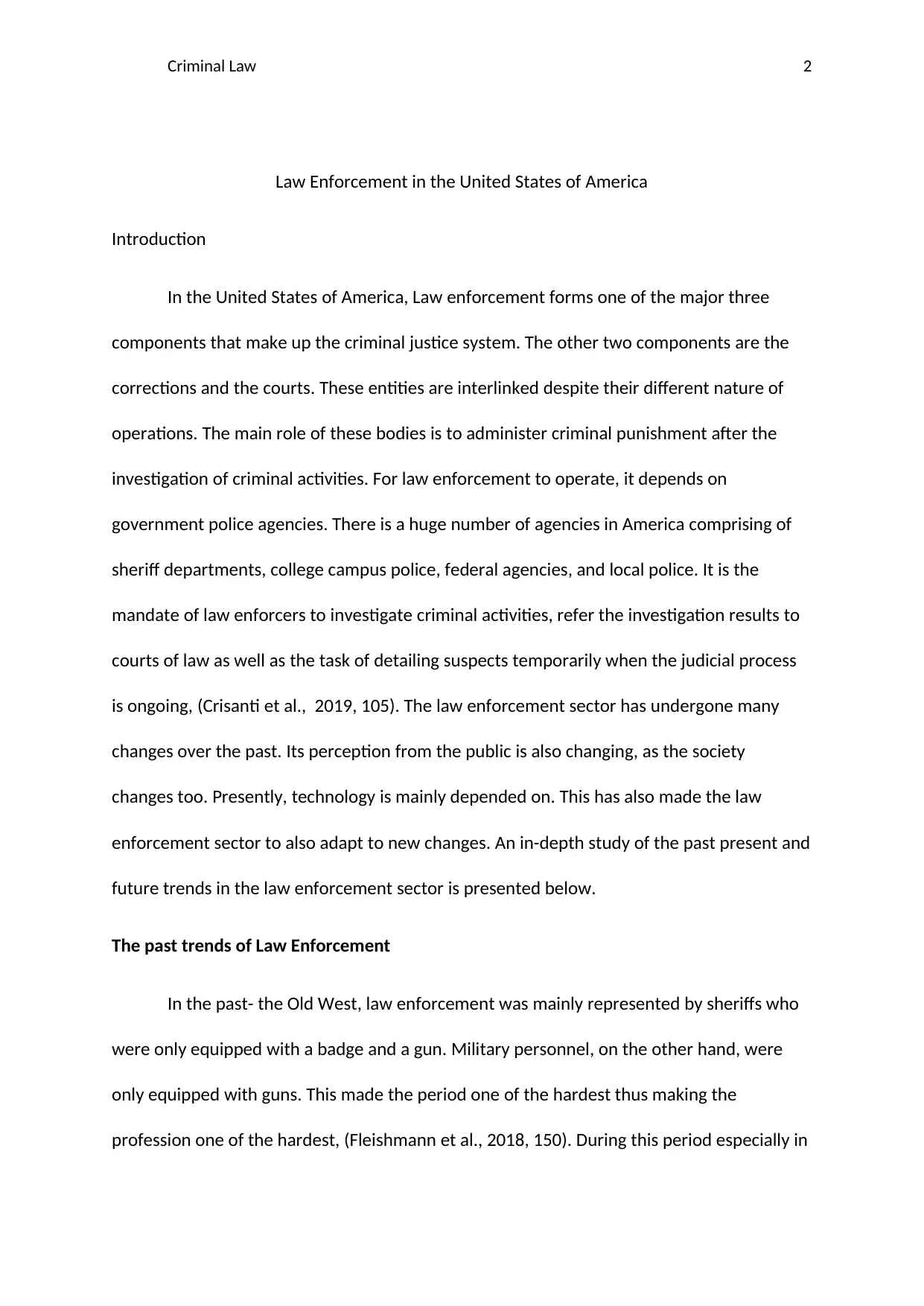
Criminal Law 2
Law Enforcement in the United States of America
Introduction
In the United States of America, Law enforcement forms one of the major three
components that make up the criminal justice system. The other two components are the
corrections and the courts. These entities are interlinked despite their different nature of
operations. The main role of these bodies is to administer criminal punishment after the
investigation of criminal activities. For law enforcement to operate, it depends on
government police agencies. There is a huge number of agencies in America comprising of
sheriff departments, college campus police, federal agencies, and local police. It is the
mandate of law enforcers to investigate criminal activities, refer the investigation results to
courts of law as well as the task of detailing suspects temporarily when the judicial process
is ongoing, (Crisanti et al., 2019, 105). The law enforcement sector has undergone many
changes over the past. Its perception from the public is also changing, as the society
changes too. Presently, technology is mainly depended on. This has also made the law
enforcement sector to also adapt to new changes. An in-depth study of the past present and
future trends in the law enforcement sector is presented below.
The past trends of Law Enforcement
In the past- the Old West, law enforcement was mainly represented by sheriffs who
were only equipped with a badge and a gun. Military personnel, on the other hand, were
only equipped with guns. This made the period one of the hardest thus making the
profession one of the hardest, (Fleishmann et al., 2018, 150). During this period especially in
Law Enforcement in the United States of America
Introduction
In the United States of America, Law enforcement forms one of the major three
components that make up the criminal justice system. The other two components are the
corrections and the courts. These entities are interlinked despite their different nature of
operations. The main role of these bodies is to administer criminal punishment after the
investigation of criminal activities. For law enforcement to operate, it depends on
government police agencies. There is a huge number of agencies in America comprising of
sheriff departments, college campus police, federal agencies, and local police. It is the
mandate of law enforcers to investigate criminal activities, refer the investigation results to
courts of law as well as the task of detailing suspects temporarily when the judicial process
is ongoing, (Crisanti et al., 2019, 105). The law enforcement sector has undergone many
changes over the past. Its perception from the public is also changing, as the society
changes too. Presently, technology is mainly depended on. This has also made the law
enforcement sector to also adapt to new changes. An in-depth study of the past present and
future trends in the law enforcement sector is presented below.
The past trends of Law Enforcement
In the past- the Old West, law enforcement was mainly represented by sheriffs who
were only equipped with a badge and a gun. Military personnel, on the other hand, were
only equipped with guns. This made the period one of the hardest thus making the
profession one of the hardest, (Fleishmann et al., 2018, 150). During this period especially in

Criminal Law 3
the 1900s, horses were the main mode of transportation as well as crowd control. The roads
were not paved hence the use of footpaths during patrols as well as uneven sidewalks. This
also characterized the Political Era mainly that ran from 1840 until 1920. It was a norm for
law enforcers to have close ties with politicians and vice versa. This made the period to be
named the “Political Era”.
This era was characterized by the use of police call boxes, the telephone, telegraph
and the Bertillon system for criminal identification. By the year 1920, more police officers
were equipped with nightsticks and guns thus marking the start of the Professional Model
Era. Reformists also advocated for the separation of police activities from political activities.
This was aimed at cleaning up the police force. Polygraphs were also introduced as well as
fingerprinting methods that were effective. In addition, more automobiles were introduced
as well as the use of handwriting classification systems. Subsequently, radar technologies
were introduced as well as two-way radio communications. Most importantly, local
governments and the states were given money by the Federal Government so that they
could control crime with ease. It was also during this era that the 911 emergency calling
services were introduced.
After the Political Era, the Professional Model Era bore community policing which
has been passed on to the current law enforcement regime. Technological advancement
also boosted law enforcement. Community policing was also computerized with the use of
Computer Aided Dispatch followed by the formation of the National Crime Information
Center, (Fortune, Rooney & Kirwan, 2018, 139). In addition, the Automated Fingerprint
Identification System was introduced. The most important forms of communications during
this period were invented by Samuel Morse and William Cooke who invented the Morse
the 1900s, horses were the main mode of transportation as well as crowd control. The roads
were not paved hence the use of footpaths during patrols as well as uneven sidewalks. This
also characterized the Political Era mainly that ran from 1840 until 1920. It was a norm for
law enforcers to have close ties with politicians and vice versa. This made the period to be
named the “Political Era”.
This era was characterized by the use of police call boxes, the telephone, telegraph
and the Bertillon system for criminal identification. By the year 1920, more police officers
were equipped with nightsticks and guns thus marking the start of the Professional Model
Era. Reformists also advocated for the separation of police activities from political activities.
This was aimed at cleaning up the police force. Polygraphs were also introduced as well as
fingerprinting methods that were effective. In addition, more automobiles were introduced
as well as the use of handwriting classification systems. Subsequently, radar technologies
were introduced as well as two-way radio communications. Most importantly, local
governments and the states were given money by the Federal Government so that they
could control crime with ease. It was also during this era that the 911 emergency calling
services were introduced.
After the Political Era, the Professional Model Era bore community policing which
has been passed on to the current law enforcement regime. Technological advancement
also boosted law enforcement. Community policing was also computerized with the use of
Computer Aided Dispatch followed by the formation of the National Crime Information
Center, (Fortune, Rooney & Kirwan, 2018, 139). In addition, the Automated Fingerprint
Identification System was introduced. The most important forms of communications during
this period were invented by Samuel Morse and William Cooke who invented the Morse
⊘ This is a preview!⊘
Do you want full access?
Subscribe today to unlock all pages.

Trusted by 1+ million students worldwide
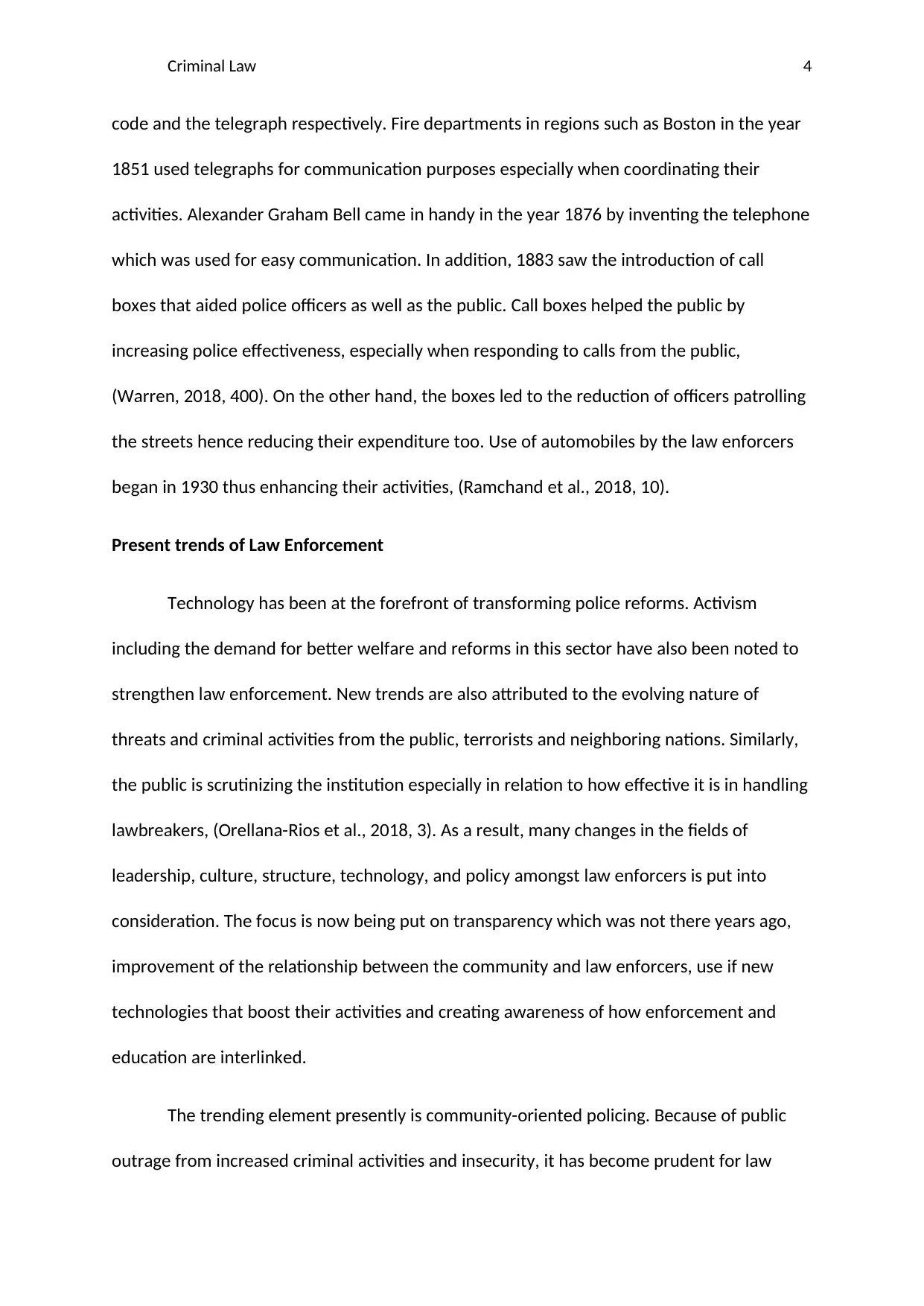
Criminal Law 4
code and the telegraph respectively. Fire departments in regions such as Boston in the year
1851 used telegraphs for communication purposes especially when coordinating their
activities. Alexander Graham Bell came in handy in the year 1876 by inventing the telephone
which was used for easy communication. In addition, 1883 saw the introduction of call
boxes that aided police officers as well as the public. Call boxes helped the public by
increasing police effectiveness, especially when responding to calls from the public,
(Warren, 2018, 400). On the other hand, the boxes led to the reduction of officers patrolling
the streets hence reducing their expenditure too. Use of automobiles by the law enforcers
began in 1930 thus enhancing their activities, (Ramchand et al., 2018, 10).
Present trends of Law Enforcement
Technology has been at the forefront of transforming police reforms. Activism
including the demand for better welfare and reforms in this sector have also been noted to
strengthen law enforcement. New trends are also attributed to the evolving nature of
threats and criminal activities from the public, terrorists and neighboring nations. Similarly,
the public is scrutinizing the institution especially in relation to how effective it is in handling
lawbreakers, (Orellana-Rios et al., 2018, 3). As a result, many changes in the fields of
leadership, culture, structure, technology, and policy amongst law enforcers is put into
consideration. The focus is now being put on transparency which was not there years ago,
improvement of the relationship between the community and law enforcers, use if new
technologies that boost their activities and creating awareness of how enforcement and
education are interlinked.
The trending element presently is community-oriented policing. Because of public
outrage from increased criminal activities and insecurity, it has become prudent for law
code and the telegraph respectively. Fire departments in regions such as Boston in the year
1851 used telegraphs for communication purposes especially when coordinating their
activities. Alexander Graham Bell came in handy in the year 1876 by inventing the telephone
which was used for easy communication. In addition, 1883 saw the introduction of call
boxes that aided police officers as well as the public. Call boxes helped the public by
increasing police effectiveness, especially when responding to calls from the public,
(Warren, 2018, 400). On the other hand, the boxes led to the reduction of officers patrolling
the streets hence reducing their expenditure too. Use of automobiles by the law enforcers
began in 1930 thus enhancing their activities, (Ramchand et al., 2018, 10).
Present trends of Law Enforcement
Technology has been at the forefront of transforming police reforms. Activism
including the demand for better welfare and reforms in this sector have also been noted to
strengthen law enforcement. New trends are also attributed to the evolving nature of
threats and criminal activities from the public, terrorists and neighboring nations. Similarly,
the public is scrutinizing the institution especially in relation to how effective it is in handling
lawbreakers, (Orellana-Rios et al., 2018, 3). As a result, many changes in the fields of
leadership, culture, structure, technology, and policy amongst law enforcers is put into
consideration. The focus is now being put on transparency which was not there years ago,
improvement of the relationship between the community and law enforcers, use if new
technologies that boost their activities and creating awareness of how enforcement and
education are interlinked.
The trending element presently is community-oriented policing. Because of public
outrage from increased criminal activities and insecurity, it has become prudent for law
Paraphrase This Document
Need a fresh take? Get an instant paraphrase of this document with our AI Paraphraser
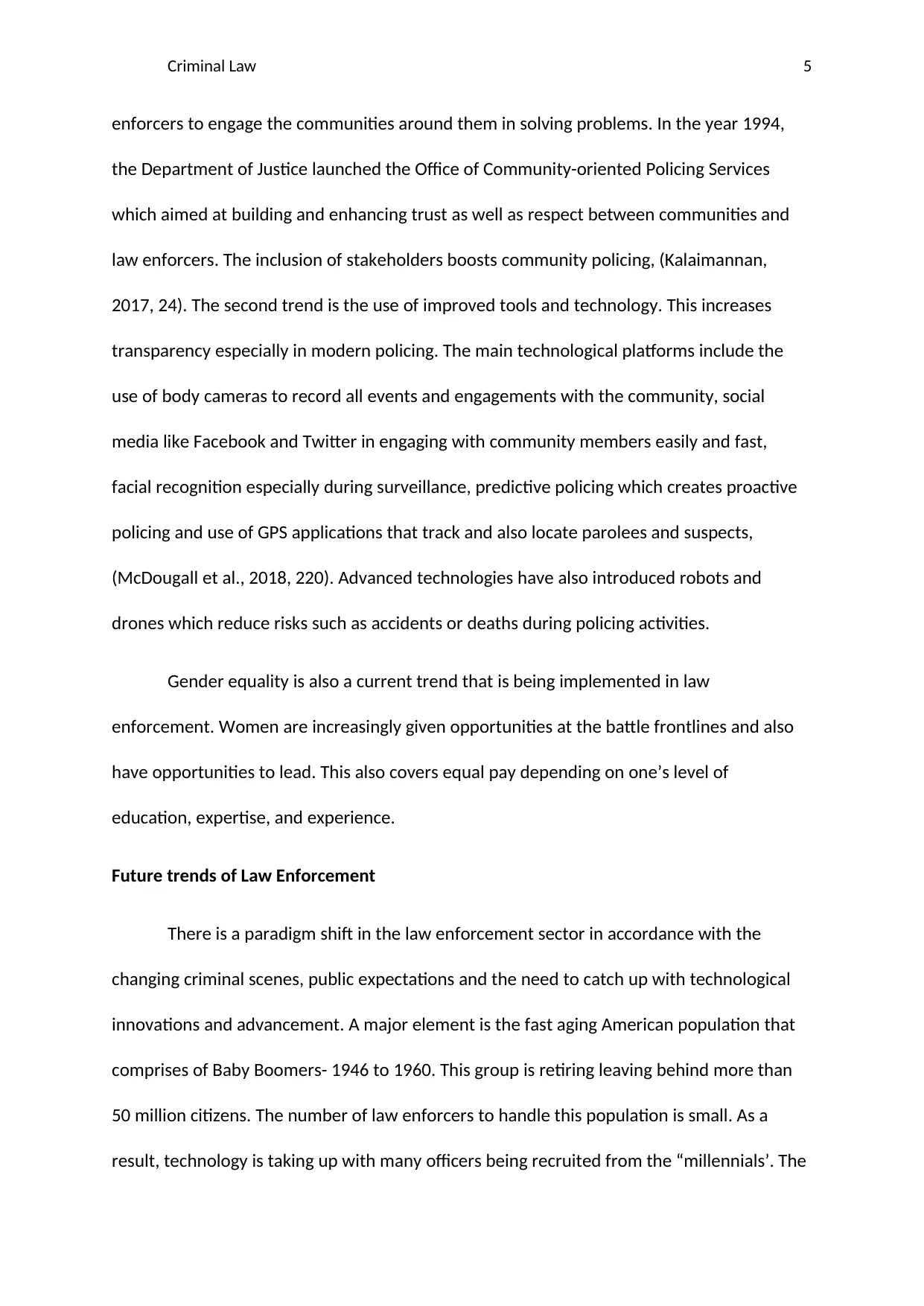
Criminal Law 5
enforcers to engage the communities around them in solving problems. In the year 1994,
the Department of Justice launched the Office of Community-oriented Policing Services
which aimed at building and enhancing trust as well as respect between communities and
law enforcers. The inclusion of stakeholders boosts community policing, (Kalaimannan,
2017, 24). The second trend is the use of improved tools and technology. This increases
transparency especially in modern policing. The main technological platforms include the
use of body cameras to record all events and engagements with the community, social
media like Facebook and Twitter in engaging with community members easily and fast,
facial recognition especially during surveillance, predictive policing which creates proactive
policing and use of GPS applications that track and also locate parolees and suspects,
(McDougall et al., 2018, 220). Advanced technologies have also introduced robots and
drones which reduce risks such as accidents or deaths during policing activities.
Gender equality is also a current trend that is being implemented in law
enforcement. Women are increasingly given opportunities at the battle frontlines and also
have opportunities to lead. This also covers equal pay depending on one’s level of
education, expertise, and experience.
Future trends of Law Enforcement
There is a paradigm shift in the law enforcement sector in accordance with the
changing criminal scenes, public expectations and the need to catch up with technological
innovations and advancement. A major element is the fast aging American population that
comprises of Baby Boomers- 1946 to 1960. This group is retiring leaving behind more than
50 million citizens. The number of law enforcers to handle this population is small. As a
result, technology is taking up with many officers being recruited from the “millennials’. The
enforcers to engage the communities around them in solving problems. In the year 1994,
the Department of Justice launched the Office of Community-oriented Policing Services
which aimed at building and enhancing trust as well as respect between communities and
law enforcers. The inclusion of stakeholders boosts community policing, (Kalaimannan,
2017, 24). The second trend is the use of improved tools and technology. This increases
transparency especially in modern policing. The main technological platforms include the
use of body cameras to record all events and engagements with the community, social
media like Facebook and Twitter in engaging with community members easily and fast,
facial recognition especially during surveillance, predictive policing which creates proactive
policing and use of GPS applications that track and also locate parolees and suspects,
(McDougall et al., 2018, 220). Advanced technologies have also introduced robots and
drones which reduce risks such as accidents or deaths during policing activities.
Gender equality is also a current trend that is being implemented in law
enforcement. Women are increasingly given opportunities at the battle frontlines and also
have opportunities to lead. This also covers equal pay depending on one’s level of
education, expertise, and experience.
Future trends of Law Enforcement
There is a paradigm shift in the law enforcement sector in accordance with the
changing criminal scenes, public expectations and the need to catch up with technological
innovations and advancement. A major element is the fast aging American population that
comprises of Baby Boomers- 1946 to 1960. This group is retiring leaving behind more than
50 million citizens. The number of law enforcers to handle this population is small. As a
result, technology is taking up with many officers being recruited from the “millennials’. The

Criminal Law 6
second trend is how immigration will affect the operations of law enforcers, (Luetsch, 2018,
23). More people are moving into the United States in search of a better life. It is estimated
that there are about 12 million undocumented immigrants and this is bound to grow in the
future. This leads to the exchange of many cultures which law enforcers have to adapt to.
An example being the way Muslim women should be handled by men. In some situations,
handling such individuals in the wrong way- contrary to the culture, leads to disagreements
and eventual aggravated relations between the police and community members. Domestic
terrorism is also a future trend that should be looked into. Active shooter incidents are on
the increase as well as the call for more jihadists to move into America by Al Qaida, (Feely,
2017, 130). Foreign students may lead to violence too because of discrimination hence the
need for more information to be shared by law enforcers. On a brighter note, technology
will boost how the law enforcement sector works especially with the use of drones and
body cameras more and more as explained earlier.
Discuss the budgetary and managerial impact that future trends will likely have not only
on the component you select but also on the other components of the criminal justice
system
The main future trends discussed above include the use of drones and body cameras
during law enforcement. Body cameras purchased by the New Orleans Police Department,
for example, cost $1.2 million dollars. For the entire nation to be covered, a lot of money
has to be used. Sophisticated drones will also be used in the future hence the need to
allocate more funding, (Rava et al., 2017, 342). The estimated budget for future drones is
$6.97 billion for the purposes of research, procurement, and development.
second trend is how immigration will affect the operations of law enforcers, (Luetsch, 2018,
23). More people are moving into the United States in search of a better life. It is estimated
that there are about 12 million undocumented immigrants and this is bound to grow in the
future. This leads to the exchange of many cultures which law enforcers have to adapt to.
An example being the way Muslim women should be handled by men. In some situations,
handling such individuals in the wrong way- contrary to the culture, leads to disagreements
and eventual aggravated relations between the police and community members. Domestic
terrorism is also a future trend that should be looked into. Active shooter incidents are on
the increase as well as the call for more jihadists to move into America by Al Qaida, (Feely,
2017, 130). Foreign students may lead to violence too because of discrimination hence the
need for more information to be shared by law enforcers. On a brighter note, technology
will boost how the law enforcement sector works especially with the use of drones and
body cameras more and more as explained earlier.
Discuss the budgetary and managerial impact that future trends will likely have not only
on the component you select but also on the other components of the criminal justice
system
The main future trends discussed above include the use of drones and body cameras
during law enforcement. Body cameras purchased by the New Orleans Police Department,
for example, cost $1.2 million dollars. For the entire nation to be covered, a lot of money
has to be used. Sophisticated drones will also be used in the future hence the need to
allocate more funding, (Rava et al., 2017, 342). The estimated budget for future drones is
$6.97 billion for the purposes of research, procurement, and development.
⊘ This is a preview!⊘
Do you want full access?
Subscribe today to unlock all pages.

Trusted by 1+ million students worldwide

Criminal Law 7
Budgetary allocations for courts of law and correctional facilities is also projected to
increase as the trends also change. As years go by, the population increases and so do the
court cases and the need for more correctional facilities. There has been a steady allocation
of funds from 2014 up to 2018 with the figures being between $6.516 billion and $7.1
billion. In 2019, the discretionary funding set is $7.25 billion. From this, future trends will
need more funding, (Howe, 2017, 210). The correctional sector is expected to spend more
than $29.5 billion in the future. From these statistics, it is evident that future trends demand
more financial capacities for all sectors to function optimally.
Budgetary allocations for courts of law and correctional facilities is also projected to
increase as the trends also change. As years go by, the population increases and so do the
court cases and the need for more correctional facilities. There has been a steady allocation
of funds from 2014 up to 2018 with the figures being between $6.516 billion and $7.1
billion. In 2019, the discretionary funding set is $7.25 billion. From this, future trends will
need more funding, (Howe, 2017, 210). The correctional sector is expected to spend more
than $29.5 billion in the future. From these statistics, it is evident that future trends demand
more financial capacities for all sectors to function optimally.
Paraphrase This Document
Need a fresh take? Get an instant paraphrase of this document with our AI Paraphraser
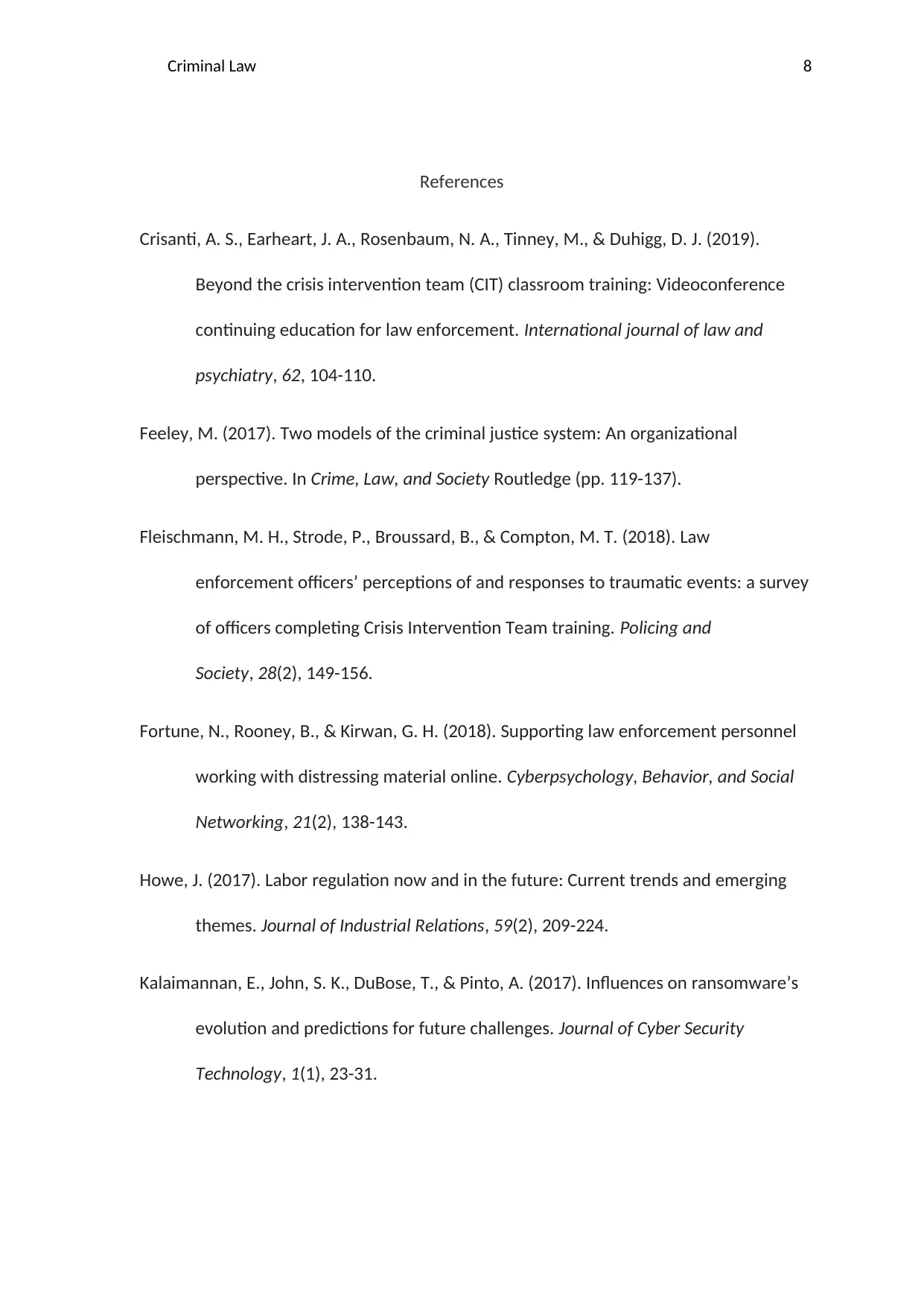
Criminal Law 8
References
Crisanti, A. S., Earheart, J. A., Rosenbaum, N. A., Tinney, M., & Duhigg, D. J. (2019).
Beyond the crisis intervention team (CIT) classroom training: Videoconference
continuing education for law enforcement. International journal of law and
psychiatry, 62, 104-110.
Feeley, M. (2017). Two models of the criminal justice system: An organizational
perspective. In Crime, Law, and Society Routledge (pp. 119-137).
Fleischmann, M. H., Strode, P., Broussard, B., & Compton, M. T. (2018). Law
enforcement officers’ perceptions of and responses to traumatic events: a survey
of officers completing Crisis Intervention Team training. Policing and
Society, 28(2), 149-156.
Fortune, N., Rooney, B., & Kirwan, G. H. (2018). Supporting law enforcement personnel
working with distressing material online. Cyberpsychology, Behavior, and Social
Networking, 21(2), 138-143.
Howe, J. (2017). Labor regulation now and in the future: Current trends and emerging
themes. Journal of Industrial Relations, 59(2), 209-224.
Kalaimannan, E., John, S. K., DuBose, T., & Pinto, A. (2017). Influences on ransomware’s
evolution and predictions for future challenges. Journal of Cyber Security
Technology, 1(1), 23-31.
References
Crisanti, A. S., Earheart, J. A., Rosenbaum, N. A., Tinney, M., & Duhigg, D. J. (2019).
Beyond the crisis intervention team (CIT) classroom training: Videoconference
continuing education for law enforcement. International journal of law and
psychiatry, 62, 104-110.
Feeley, M. (2017). Two models of the criminal justice system: An organizational
perspective. In Crime, Law, and Society Routledge (pp. 119-137).
Fleischmann, M. H., Strode, P., Broussard, B., & Compton, M. T. (2018). Law
enforcement officers’ perceptions of and responses to traumatic events: a survey
of officers completing Crisis Intervention Team training. Policing and
Society, 28(2), 149-156.
Fortune, N., Rooney, B., & Kirwan, G. H. (2018). Supporting law enforcement personnel
working with distressing material online. Cyberpsychology, Behavior, and Social
Networking, 21(2), 138-143.
Howe, J. (2017). Labor regulation now and in the future: Current trends and emerging
themes. Journal of Industrial Relations, 59(2), 209-224.
Kalaimannan, E., John, S. K., DuBose, T., & Pinto, A. (2017). Influences on ransomware’s
evolution and predictions for future challenges. Journal of Cyber Security
Technology, 1(1), 23-31.
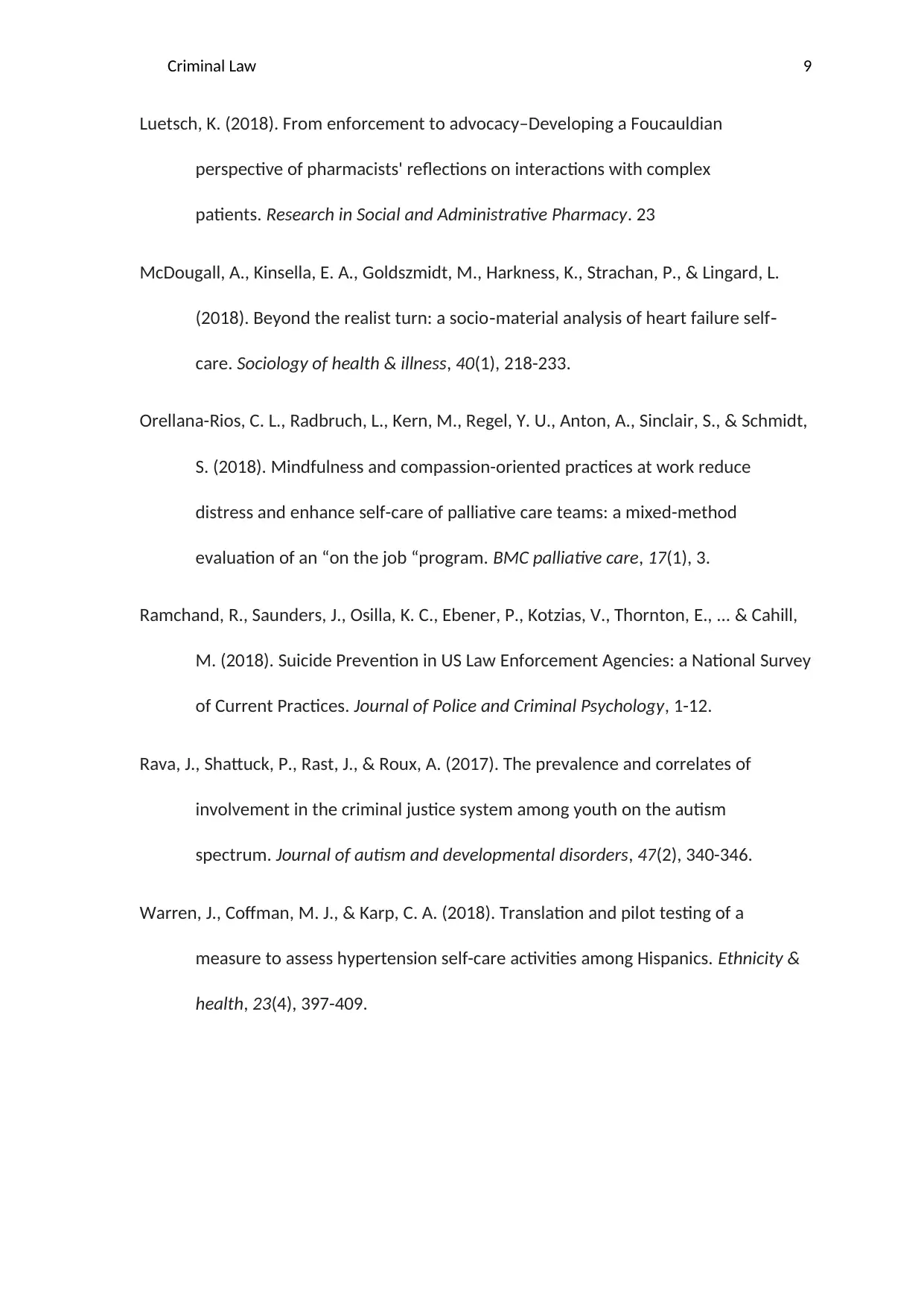
Criminal Law 9
Luetsch, K. (2018). From enforcement to advocacy–Developing a Foucauldian
perspective of pharmacists' reflections on interactions with complex
patients. Research in Social and Administrative Pharmacy. 23
McDougall, A., Kinsella, E. A., Goldszmidt, M., Harkness, K., Strachan, P., & Lingard, L.
(2018). Beyond the realist turn: a socio‐material analysis of heart failure self‐
care. Sociology of health & illness, 40(1), 218-233.
Orellana-Rios, C. L., Radbruch, L., Kern, M., Regel, Y. U., Anton, A., Sinclair, S., & Schmidt,
S. (2018). Mindfulness and compassion-oriented practices at work reduce
distress and enhance self-care of palliative care teams: a mixed-method
evaluation of an “on the job “program. BMC palliative care, 17(1), 3.
Ramchand, R., Saunders, J., Osilla, K. C., Ebener, P., Kotzias, V., Thornton, E., ... & Cahill,
M. (2018). Suicide Prevention in US Law Enforcement Agencies: a National Survey
of Current Practices. Journal of Police and Criminal Psychology, 1-12.
Rava, J., Shattuck, P., Rast, J., & Roux, A. (2017). The prevalence and correlates of
involvement in the criminal justice system among youth on the autism
spectrum. Journal of autism and developmental disorders, 47(2), 340-346.
Warren, J., Coffman, M. J., & Karp, C. A. (2018). Translation and pilot testing of a
measure to assess hypertension self-care activities among Hispanics. Ethnicity &
health, 23(4), 397-409.
Luetsch, K. (2018). From enforcement to advocacy–Developing a Foucauldian
perspective of pharmacists' reflections on interactions with complex
patients. Research in Social and Administrative Pharmacy. 23
McDougall, A., Kinsella, E. A., Goldszmidt, M., Harkness, K., Strachan, P., & Lingard, L.
(2018). Beyond the realist turn: a socio‐material analysis of heart failure self‐
care. Sociology of health & illness, 40(1), 218-233.
Orellana-Rios, C. L., Radbruch, L., Kern, M., Regel, Y. U., Anton, A., Sinclair, S., & Schmidt,
S. (2018). Mindfulness and compassion-oriented practices at work reduce
distress and enhance self-care of palliative care teams: a mixed-method
evaluation of an “on the job “program. BMC palliative care, 17(1), 3.
Ramchand, R., Saunders, J., Osilla, K. C., Ebener, P., Kotzias, V., Thornton, E., ... & Cahill,
M. (2018). Suicide Prevention in US Law Enforcement Agencies: a National Survey
of Current Practices. Journal of Police and Criminal Psychology, 1-12.
Rava, J., Shattuck, P., Rast, J., & Roux, A. (2017). The prevalence and correlates of
involvement in the criminal justice system among youth on the autism
spectrum. Journal of autism and developmental disorders, 47(2), 340-346.
Warren, J., Coffman, M. J., & Karp, C. A. (2018). Translation and pilot testing of a
measure to assess hypertension self-care activities among Hispanics. Ethnicity &
health, 23(4), 397-409.
⊘ This is a preview!⊘
Do you want full access?
Subscribe today to unlock all pages.

Trusted by 1+ million students worldwide

Criminal Law 10
1 out of 10
Your All-in-One AI-Powered Toolkit for Academic Success.
+13062052269
info@desklib.com
Available 24*7 on WhatsApp / Email
![[object Object]](/_next/static/media/star-bottom.7253800d.svg)
Unlock your academic potential
Copyright © 2020–2026 A2Z Services. All Rights Reserved. Developed and managed by ZUCOL.

